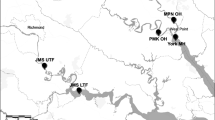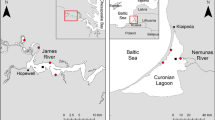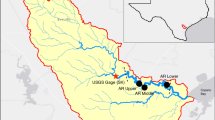Abstract
Plant pigments in particulate organic carbon were examined in the lower Mississippi and Pearl Rivers (U.S.), along with physical variables and nutrients to study seasonal changes in the abundance and composition of phytoplankton. Water samples were collected monthly from September 2001 to August 2003 in the lower Mississippi River (MR; no samples were taken in February 2002) and from August 2001 to July 2003 in the Pearl River (PR). High concentrations of total suspended solids (TSS), nutrients, and chlorophylla (chla; dominated by diatoms) were observed in the lower MR. The smaller blackwater PR was characterized by lower nutrients and chla, higher ultraviolet absorbance, and a phytoplankton biomass dominated by chlorophytes. Chla concentrations in the lower MR was high in summer low-flow periods and also during interims of winter and spring, and did not couple with physical variables and nutrients, likely due to a combination of in situ production and inputs from reservoirs, navigation locks and oxbow lakes in the upper MR and Missouri River. Chla concentrations in the PR was only high in summer low-flow periods and were controlled by temperature and concentrations of chromophoric dissolved organic matter 9CDOM). The high, diatom-dominated phytoplankton biomass in the lower MR was likely the result of decreasing TSS (increased damming in the watershed) and increasing nutrients (enhanced agricultural runoff) over the past few decades. Lower phytoplankton biomass (dominated by chlorophytes) in the PR was likely linked with intense shading by CDOM and lower availability of nutrient inputs. An increase in the relative importance of phytoplankton biomass in large turbid rivers, such as the MR, could have significant effects on the age and lability of riverine organic matter entering the ocean, the stoichiometric balance of nutrients delivered to coastal margins, and the sequestration of atmospheric CO2 in these dynamic regions.
Similar content being viewed by others
Literature Cited
Admiraal, W., L. Breebaart, G. M. J. Tubbing, B. Zenten, E. D. Sw Ruyter Van Steveninck andR. Bijkerk. 1994. Seasonal variation in composition and production of planktonic communities in the lower River Rhine.Freshwater Biology 32:519–531.
Anderson, L. 1979. Simultaneous spectrophotometric determination of nitrite and nitrate by flow injection analysis.Analytica Chimica Acta 110:123–128.
Baker, A. L. andK. K. Baker. 1979. Effects of temperature and cruurent discharge on the concentration and photosynthetic activity of the phytoplankton in the upper Mississippi River.Freshwater Biology 9:191–198.
Baker, K. K. andA. L. Barker. 1981. Seasonal succession of the phytoplankton in the upper Mississippi River.Hydrobiologica 83: 295–301.
Basu, B. K. andF. R. Pick. 1996. Factors regulating phytoplankton and zooplankton biomass in temperate rivers.Limnology and Oceanography 41:1572–1577.
Bianchi, T. S. andM. E. Argyrou. 1997. Temporal and spatial dynamics of particulate organic carbon in the Lake Pontchartrain estuary, southeast Louisiana, USA.Estuarine Coastal and Shelf Science 45:557–569.
Bianchi, T. S., R. Dawson, andP. Sawangwong. 1988. The effects of macrobenthic deposit-feeding on the degradation of chloropigments in sandy sediments.Journal of Experimental Marine Biology and Ecology 122:243–255.
Bianchi, T. S., C. Lambert, P. H. Santschi, M. Baskaran, andL. Guo. 1995. Plant pigments as biomarkers of high-molecular-weight dissolved organic-carbon.Limnology and Oceanography 40: 422–428.
Bianchi, T. S., T. Filley, K. Dria, andP. G. Hatcher. 2004. Temporal variability in sources of dissolved organic carbon in the lower Mississippi River.Geochemica et Cosmochimica Acta 68: 959–967.
Bianchi, T. S., S. Findlay, andD. Fontvieille. 1991. Experimental degradation of plant materials in Hudson River sediments. I. Heterotrophic transformations of plant pigments.Biogeochemistry 12:171–187.
Bledsoe, E. L. andE. J. Philips. 2000. Relationships between phytoplankton standing crop and physical, chemical, and biological gradients in the Suwannee River and Plume region, USA.Estuaries 23:458–473.
Canfield, D. E. 1997. The geochemistry of river particulates from the continental USA: Major elements.Geochemica et Cosmochimica Acta 61:3349–3365.
Cartaxana, P., B. Jesus, andV. Brotas. 2003. Pheophorbide and pheophytin a-like pigments as useful markers for intertidal microphytobenthos grazing byHydrobia ulvae.Estuarine Coastal and Shelf Science 58:293–297.
Chen, N. H., T. S. Bianchi, andJ. M. Bland 2003a. Novel decomposition products of chlorophyll-alpha in continental shelf (Louisiana shelf) sediemnts: Formation and transformation of carotenol chlorin esters.Geochemica et Cosmochimica Acta 67:2027–2042.
Chen, N. H., T. S. Bianchi, andJ. M. Bland. 2003b. Implications for the role of pre- versus post-depositional transformation of chlorophyll-a in the Lower Mississippi River and Louisiana shelf.Marine Chemistry 81:37–55.
Chen, N. H., T. S. Bianchi, B. A. McKee, andJ. M. Bland. 2001. Historical trends of hypoxia on the Louisiana shelf: Application of pigments as biomarkers.Organic Geochemistry 32:543–561.
Chin, Y. P., G. Aiken, andE. O. Loughlin. 1994. Molecular weight, polydispersivity, and spectroscopic properties of aquatic humic substances.Environmental Science and Technology 28:1853–1858.
Cole, J. J., N. F. Caraco, andB. Peierls. 1992. Can phytoplankton achieve a positive carbon balance in a turbid river, the Hudson River, New York?.Limnology and Oceanography 37:1608–1617.
Conley, D. J. 1997. Riverine contribution of biogenic silica to the oceanic silica budget.Limnology and Oceanography 42:774–777.
Dagg, M. J., T. S. Bianchi, G. A. Breed, W.-J. Cai, S. Duan, H. Liu, B. M. McKee, R. T. Powell, andM. C. Stewart. 2005. Biogeochemical characteristics of the lower Mississippi River, USA, during Juen 2003.Estuaries 28:664–674.
DeMaster, D. J., G. B. Knapp, andC. A. Nittrouer. 1983. Biological uptake and accumulation of silica on the Amazon continental shelf.Geochemica et Cosmochimica Acta 47:1713–1723.
Descy, J. P., H. W. Higgins, D. J. Mackey, J. P. Hurley, andT. M. Frost. 2000. Pigment ratios and phytoplankton assessment in northern Wisconsin lakes.Journal of Phycology 36:274–286.
Descy, J. P., P. Servais, J. S. Smitz, G. Billen, andE. Everbecq. 1987. Phytoplankton biomass and production in the River Meuse (Belgium).Water Research 21:1557–1566.
Dortch, Q. andT. E. Whitledge. 1992. Does nitrogen or silicon limit phytoplankton production in Mississippi River Plume and nearby regions.Continental Shelf Refearch 12:1293–1309.
Gaillardet, J., B. Dupre, andC. J. Allegre. 1999. Goechemistry of large river suspended sediemnts: Silicate weathering or recycling tracer?.Geochemica et Cosmochimica Acta 63:4037–4051.
Goolsby, D. A., W. A. Battaglin, B. T. Aulenbach, andR. P. Hooper. 2000. Nitrogen flux and sources in the Mississippi River Basin.The Science of the Total Environment 248:75–86.
Hecky, R. E. andP. Kilham. 1988. Nutrient limitation of phytoplankton in freshwater and marine environment.Limnology and Oceanography 33:796–822.
Hedges, J. I. andR. G. Keil. 1995. Sedimentary organic-matter preservation—An assessment and speculative synthesis.Marine Chemistry 49:81–115.
Hedges, J. I. andJ. H. Stern. 1984. Carbon and nitrogen determinations of carbonate-containing solids.Limnology and Oceanography 29:657–663.
Huff, D. R. 1986. Phytoplankton communities in navigation pool No 7 of the upper Mississippi River.Hydrobiologia 136:47–56.
Humborg, C., D. J. Conley, L. Rahm, F. Wulff, A. Cociasu, andV. Ittekkot. 2000. Silicon retention in river basins: Far-reaching effects on biogeochemistry and aquatic food webs in coastal marine environments.AMBIO 29:45–50.
Humborg, C., V. Ittekkot, A. Cociasu, andB. V. Bodungen. 1997. Effect of Danube River dam on Black Sea biogeochemistry and ecosystem structure.Nature 386:385–388.
Ittekkot, V.. 1988 Global trends in the nature of organic-matter in river suspensions.Nature 332:436–438.
Ittekkot, V., C. Humborg, andP. Schafer. 2000. Hydrological alterations and marine biogeochemistry: A silicate issue?Bioscience 50:776–782.
Jeffrey, S. W. 1980. Algal pigment systems, p. 33–57.In P. G. Falkowski (ed.), Primary Productivity in the Sea, Volume 19. Plenum Publishing Corp., New York.
Junk, W. J., P. B. Bayley, andR. E. Sparks. 1989. The flood-pulse concept in river-floodplain system.Canadian Journal of Fishery and Aquatic Science 106:110–127.
Justic, D., N. N. Rabalais, andR. E. Turner. 1995. Stoichiometric nutrient balance and origin of coastal eutrophication.Marine Pollution Bulletin 30:41–46.
Kendall, C., S. R. Silva, andV. J. Kelly. 2001. Carbon and nitrogen isotopic compositions of particulate organic matter in four large river systems across the United States.Hydrological Process 15:1301–1346.
Keown, M. P., E. A. Dardeau, andE. M. Causey. 1986. Historic trends in the sediemnt flow regime of the Mississippi River.Water Resource Research 22:1555–1564.
Kiss, K. T. 1994. Trophic level and eutrophication of the River Danube in Hungary. Internationale Vereinigung fuer Theoretische und Angewandte Limnologie Verhandlungen. 25:1688–1691.
Knowlton, M. F. andJ. R. Jones. 1997. Trophic status of Missouri River floodplain lakes in relation to basin type and connectivity.Wetlands 17:468–475.
Knowlton, M. F. andJ. R. Jones. 2000. Seston, light, nutrients and chlorophyll in the lower Missouri River, 1984–1998.Journal of Freshwater Ecology 15:283–297.
Köhler, J. 1995. Growth, production and losses of phytoplankton in the lowland River Spree: Carbon balance.Freshwater Biology 34:501–512.
Lewttus, A. J., D. L. White, R. G. Tymowski, M. E. Geesey, S. N. Hymel, andP. A. Noble. 2005. Adapting the CHEMTAX method for assessing phytoplankton taxonomic composition in southeastern US estuaries.Estuaries 28:160–172.
Lohrenz, S. E., G. L. Fahnenstiel, D. G. Redalje, G. A. Lang, X. G. Chen, andM. J. Dagg. 1997. Variations in primary production of northern Gulf of Mexico continental shelf waters linked to nutrient inputs from the Mississippi River.Marine Ecology Progress Series 155:45–54.
Lohrenz, S. E., G. L. Fahnenstiel, D. G. Redalje, G. A. Lang, M. J. Dagg, T. E. Whitledge, andQ. Dortch. 1999. Nutrients, irradiance, and mixing as factors regulating primary production in coastal waters impacted by the Mississippi River plume.Continental Shelf Research 19:1113–1141.
Mackey, M. D., D. J. Mackey, H. W. Higginsand, andS. Wright. 1996. CHEMTAX-A program for estimating class abundances from chemical markers: Application to HPLC measurements of phytoplankton.Marine Ecology Progress Series 144:265–283.
Mayer, L. M., R. G. Meil, S. A. Macko, S. B. Joye, K. C. Ruttenberg, andR. C. Aller. 1998. Importance of suspended particulates in riverine delivery of bioavailable nitrogen to coastal zones.Global biogeochemical Cycles 12:573–579.
McCormick, P. V., M. B. O'Dell, R. B. E. Shuford, J. G. Backus, andW. C. Kennedy. 2001. Periphyton responses to experimental phosphorus enrichment in a subtropical wetland.Aquatic Botany 71:119–139.
McPherson, B. F. andR. L. Miller. 1987. Cause of light attenuation in Tampa Bay and Charlotte Harbor, southwestern Florida.Water Resource Bulletin 30:43–53.
Meade, R. H., T. R. Yuzyk, andT. J. Day. 1990. Movement and storage of sediment in rivers of the United States and canada, p. 255–280.In M. G. Wolman and H. C. Riggs (eds.), Surface Water Hydrology. Geological Society of America, Boulder, Colorado.
Meybeck, M. 1982. Carbon, nitrogen, and phosphorus transport by world rivers.American Journal of Science 282:401–450.
Milliman, J. 1991. Flux and fate of fluvial sediment and water in coastal seas, p. 69–90.In R. F. C. Mantoura, J. Martin, and R. Wollast (eds.), Ocean Margin Processes in Global Change. Wiley, New York.
Moran, M. A. andR. E. Hodson. 1990. Bacterial production on humic and nonhumic components of dissolved organic carbon.Limnology and Oceanography 35:1744–1756.
Moran, M. A., W. M. Sheldon, andJ. E. Sheldon. 1999. Biodegradation of riverine dissolved organic carbon in five estuaries of the southeastern United States.Estuaries 22:55–64.
Mullin, J. B. andJ. P. Riley. 1955. The colorimetric determination of silicate with special reference to sea and natural waters.Analytica Chimica Acta 12:162–176.
Murphy, J. andJ. P. Riley. 1962. A modified single solution method for determination of phosphate in natural waters.Analytica Chimica Acta 26:31–36.
Onstad, G. D., D. E. Canfield, P. D. Quay, andJ. I. Hedges. 2000. Sources of particulate organic matter in rivers from the continental USA: Lignin phenol and stable carbon isotope compositions.Geochemica et Cosmochimica Acta 64:3539–3546.
Pace, M. L., S. E. G. Findlay, andD. Lints. 1992. Zooplankton in advective environments—the Hudson River community and a comparative analysis.Canadian Journal of Fisheries and Aquatic Sciences 49:1060–1069.
Patton, C. J. andS. R. Crouch. 1977. Spectrophotometric and kinetics investigation of the Berthelot reaction for the determination of ammonia.Analytical Chemistry 49:464–469.
Pinder, L. C. V., A. F. H. Marker, A. C. Pinder, J. K. G. Ingram, D. V. Leach, andG. D. Collett. 1997. Concentrations of suspended chlorophyll alpha in the Humber rivers.The Science of the Total Environmental 194:373–378.
Presley, B. J., J. H. Trefry, andR. F. Shokes. 1980. Heavy-metal inputs to Mississippi delta sediemnts—A historical view.Water, Air and Soil Pollution 13:481–494.
Rabalais, N. N., N. Atilla, C. Normandeau, andR. E. Turner. 2004. Ecosystem history of Mississippi River-influenced continental shelf revealed through preserved phytoplankton pigments.Marine Pollution Bulletin 49:537–547.
Rabalais, N. N., R. E. Turner, D. Justic', Q. Dortch, W. J. Wiseman Jr., andB. Sen Gupta. 1996. Nutrient changes in the Mississippi River and system responses on the adjacent continental shelf.Estuaries 19:386–407.
Raymond, P. A. andJ. E. Bauer. 2001. Riverine export of aged terrestrial organic matter to the North Atlantic Ocean.Nature 409:497–500.
Repeta, D. J., T. M. Quan, L. I. Aluwihare, andA. Accardi. 2002. Chemical characterization of high molecular weight dissolved organic matter in fresh and marine waters.Geochemica et Cosmochimica Acta 66:955–962.
Reynolds, C. S. andJ. W. G. Lund. 1988. The phytoplankton of an enriched, soft-water lake subject to intermittent hydraulic flushing (Grasmere, English Lake District).Freshwater Biology 19:379–404.
Reynolds, C. S. 1984. The Ecology of Freshwater Phytoplankton. Cambridge University Press, Cambridge, Massachusetts.
Ridout, P. S. andR. J. Morris. 1985. Short-term variations in the pigment composition of a spring phytoplankton bloom from an enclosed experiment ecosystem.Marine Chemistry 87:7–11.
Saliot, A., L. Mejanelle, P. Scribe, J. Fillaux, C. Pepe, A. Jabaud, andJ. Dagaut. 2001. Particulate organic carbon, sterols, fatty acids and pigments in the Amazon River system.Biogeochemistry 53:79–103.
Schagerl, M. andK. Donabaum. 1998. Epilithic algal communities on natural and artificial substrata in the River Danube near Vienna (Austria).Archiv Fur Hydrobiologie 2:153–165.
Sellers, T. andP. A. Bukaveckas. 2003. Phytoplankton production in a large, regulated river: A modeling and mass balance assessment.Limnology and Oceanography 48:1476–1487.
Skidmore, R. E., S. C. Maberly, andB. A. Whitton. 1998. Patterns of spatial and temporal variation in phytoplankton chlorophylla in the River Trent and its tributaries.The Science of the Total Environment 210/211:357–365.
Smith, V. H., G. D. Tilman, andJ. C. Nekola. 1999. Eutrophication: Impacts of excess nutrient inputs on freshwater, marine, and terrestrial ecosystems.Environmental Pollution 100:179–196.
Spooner, N., H. R. Harvey, G. E. S. Pearce, C. B. Eckarde, andJ. B. Maxwell. 1994. Biological defunctionalisation of chlorophyll in the aquatic environment. 2. Action of endogenous algal enzymes and aerobic bacteria.Organic Geochemistry 22:773–780.
Stallard, R. F. andJ. M. Edmond. 1983. Geochemistry of the Amazon. 2. The influence of geology and weathering environment on the dissolved load.Geophysical Research Letter (Atmosphere) 88:9671–9688.
Strom, S. L.. 1993. Production of pheopigments by marine protozoa—Results of laboratory experiments analyzed by HPLC.Deep-Sea Research I 40:57–80.
Sullivan, B. E., F. G. Prahl, L. F. Small, andP. A. Covert. 2001. Seasonality of phytoplankton production in the Columbia River: A natural or anthropogenic pattern?Geochemica et Cosmochimica Acta 65:1125–1139.
Szemes, G. 1967. Das phytoplankton der Donau.Limnologie Donau 5:158–159.
Thorp, J. H. andM. D. Delong. 1994. The river production model: An heuristic view of carbon sources and organic processing in large river ecosystems.Oikos 70:305–308.
Thefry, J. H., S. Metz, T. A. Nelsen, R. P. Trocine, andB. J. Eadie. 1994. Transport of particulate organic carbon by Mississippi River and its fate in the Gulf of Mexico.Estuaries 17:839–849.
Treguer, P., D. M. Nelson, A. J. van Bennekom, D. J. DeMaster, A. Leynaert, andB. Queguiner. 1995. The silica balance in the world ocean: A reestimate.Science 268:375–379.
Turner, R. E. andN. N. Rabalais. 1991. Changes in Mississippi River water quality this century.Bioscience 41:140–147.
Turner, R. E. andN. N. Rabalais. 2004. Suspended sediment, C, N, P, and Si yields from the Mississippi River Basin.Hydrobiologia 511:79–89.
Turner, R. E., N. N. Rabalais, andD. Justic, et al. 2003. Global patterns of dissolved N, P and Si in large rivers.Biogeochemistry 64:297–317.
Vannote, R. L., G. W. Minshall, K. W. Cummins, J. R. Sedell, andC. E. Cushing. 1980. The river continuum concept.Canadian Journal of Fishery and Aquatic Science 37:130–137.
Wainright, S. C., C. A. Couch, andJ. L. Meyer. 1992. Fluxes of bacteria and organic matter into a blackwater river from river sediments and floodplain soils.Freshwater Biology 28:37–48.
Walden, M. G. 1992. Mississippi River time-of-travel: User's manual. CLIWS-WQR 91.06/M. Waldon. Louisiana Department of Environmental Quality IAG# 24400-91-19. Baton Rouge, Lousiana.
Wasmund, N., M. Zalewski, andS. Busch. 1999. Phytoplankton in large river plumes in the Baltic Sea.ICES Journal of Marine Science 56:23–32.
Wehr, J. D. andJ. P. Descy. 1998. Use of phytoplankton in large river management.Journal of Phycology 3:741–749.
Wehr, J. D. andR. G. Sheath. 2003. Freshwater Algae of North America—Ecology and Classification. Academic Press, San Diego, California.
Wehr, J. D. andJ. M. Thorp. 1997. Effects of navigation dams, tributaries, and littoral zones on phytoplankton communities in the Ohio River.Canadian Journal of Fishery and Aquatic Science 54:378–395.
Wetzel, R. G. 2001. Limnology: Lake and River Ecosystems, 3rd edition. Academic Press, San Diego, California.
Whaby, S. D. andN. F. Bishara. 1980. The effect of the River Nile on Mediterranean water, before and after the construction of the High Dam at Aswan, p. 311–318.In J. M. Martin, J. D. Burton, and D. Eisma (eds.), River Inputs to Ocean Systems, UNEP-UNESCO, Gland, Switzerland.
Wright, S. W., S. W. Jeffrey, R. F. C. Mantoura, C. A. Llewellyn, T. Bjornland, D. Repeta, andN. Welschmeyer. 1991. Improved HPLC method for the analysis of carotenoids from marine phytoplankton.Marine Ecology Progress Series 77:183–196.
Wysocki, L. A., T. S. Bianchi, and T. Filley. 2003. Sources of organic carbon on the Louisiana Shelf: The use of chemical biomarkers to trace organic matter in Mississippi River Plume sediments.Abstracts of Papers of the American Chemical Society 225: U922-U922 071-GEOC Part 1.
Sources of Unpublished Materials
Pearl River Basin Team. unpublished data. 2000. Pearl River Basin 2000 Status Report. http://www.deq.state.ms.us
U.S. Geological Survey. unpublished data. http://gulfsci.usgs. gov/missriv/reports/ofrshelf
U.S. Environmental Protection Agency. unpublished data. 2004. http://www.epa.gov/emap/greatriver
Author information
Authors and Affiliations
Corresponding author
Rights and permissions
About this article
Cite this article
Duan, S., Bianchi, T.S. Seasonal changes in the abundance and composition of plant pigments in particulate organic carbon in the lower Mississippi and Pearl Rivers. Estuaries and Coasts: J ERF 29, 427–442 (2006). https://doi.org/10.1007/BF02784991
Received:
Revised:
Accepted:
Issue Date:
DOI: https://doi.org/10.1007/BF02784991




